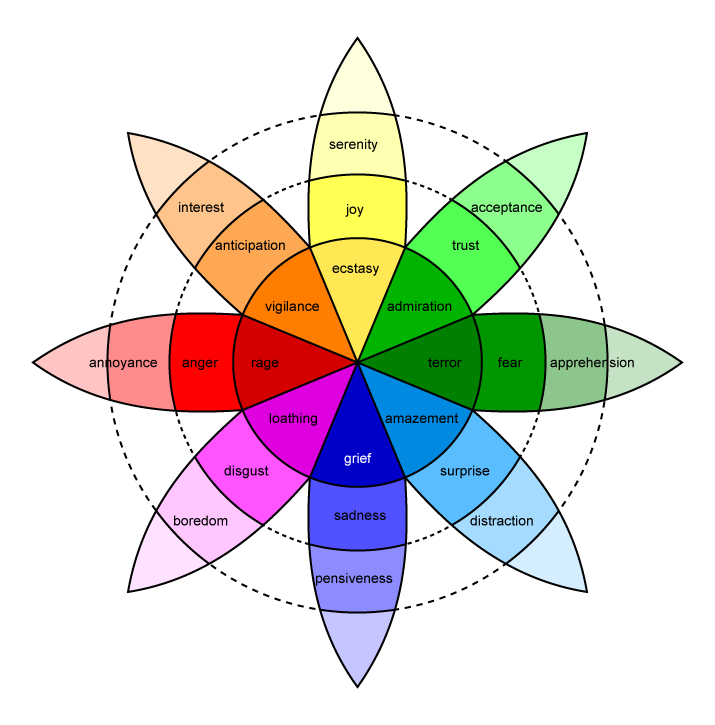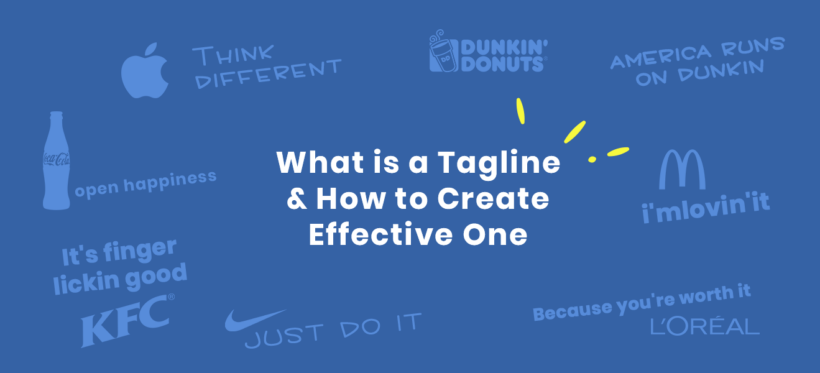Branding can be one of the heaviest things to impact marketing. It’s hard to sell something that’s not attractive, not useful, not popular, or not stylish. There are many tools to support brand image and even define it. Naming, logo, user interface, visual identity design, slogans, etc. But what about taglines? How are they different from slogans, why are they important, and how can we come up with brilliant tagline ideas without paying millions to marketing agencies? Let’s find out!
What is a tagline?
A tagline is very similar to a slogan, in a way. They both have the same goal of transmitting brand value in a single catchy phrase, communicating with the audience, and delivering a message that will be associated with the company’s values. However, there are some important differences. Taglines are slogans that live for generations and become an essential part of a brand’s philosophy. We all know the taglines ‘Just do it.’, ‘Impossible is nothing’, ‘I’m loving it’, ‘Think different’, ‘Today. Tomorrow. Toyota.’ and the companies they represent. Unlike regular slogans produced for specific ad campaigns or products, taglines are permanent.
Why does your business need a tagline?
From a bigger strategic perspective, taglines are normally the last thing marketers worry about. In support of this statement, some of them point out audiences’ ever-decreasing attention spans, the small average screen size they consume content with, are among other reasons to forget about taglines. Nonetheless, taglines to this day serve an important purpose. Through taglines, businesses briefly explain what their company is all about, without having to display long manifestos or videos. One glance at a good tagline is enough for that.
Another point is market competition. You want to stand out from the crowd of equally good companies that produce similar products. Or, you might desire to highlight some of your company’s values, attitude towards customers, or other strong sides of your services. Obviously, there are also other ways to promote a company’s values you shouldn’t forget, but a tagline is a great way to deliver a statement likely to be remembered in a couple of words.
The good thing about taglines is that they increase value over time. When used for long enough, taglines often become even more recognizable than the company name. Taglines are meant to hold together that array of marketing pieces your brand represents.
Obviously, it can backfire as statements that are clearly not realistic or misleading can become infamous rather than well known.
Types of taglines
All taglines serve one purpose but not all of them use the same approach to achieve it. There are five most popular types of taglines: Imperative, Descriptive, Provocative, Specific, and Superlative. Clearly, each of them has its flaws and virtues, so let’s review them a little more closely.
Imperative taglines. This type of tagline basically tells users what to do (or pushes them to decide) – Nike’s ‘Just do it.’, Subway’s ‘eat fresh.’, Coca-Cola’s ‘Open happiness’ for instance, are imperative taglines. Imperative taglines are more popular among big companies because the smaller ones sometimes shy away from their directness. Of course, this concern is often a mistake. If your brand is small, it doesn’t mean it can’t use that kind of tone. It works just fine no matter the size of the company (as long as it’s good). Inspirational messaging to deliver the idea is a good option for a tagline or slogan.
Descriptive taglines compare the company’s product to something interpreted as good or point out excellence in something. Examples of taglines include: KFC’s ‘Finger-licking good!’, BMW’s ‘The ultimate driving machine’, FedEx’s ‘The world on time’. A descriptive tagline approach is good to draw attention to brands’ qualities and deliver companies’ values.
Provocative taglines. In a dense marketing competition, companies always explore non-standard approaches. Taglines in this sense are not exceptional. The provocative tagline can help brands make their voice heard in a bold, unorthodox, and original way. For example, Rock’s ‘Stop slacking, start rocking!’ productivity platform mocks one of its main competitors – Slack. Some might find this kind of humor a little too much, however, you can’t deny its effectiveness and illustrative power for brand identity.
Specific taglines are meant to deliver a relatively precise piece of information. Short catchy phrases are the creative way to go, but sometimes it’s a good idea to directly tell people what your company does without any extra constructions. Will that be a brand’s mission or explanation of some working principles is a matter of discussion, but it can work better to go into that detail to benefit from a tagline. For instance, TimeTackle’s ‘Analyze calendar data, optimize team’s time.’ Short, concise, and clear, yet a super simple and effective tagline. The main advantage of this approach lies in simplicity. It doesn’t take a team of creative professionals to come up with a tagline like that.
Superlative taglines. This one’s for those who like to compare their product to other offers on the market. The only goal of a superlative tag is to explain what your company is best at. A great example of this is Budweiser’s ‘The king of beers’. Without beating around the bush it tells the customer to stop trying to find the best beer. It’s already there. In this case, it doesn’t matter if that beer was crowned by clever marketers hired by that company. The main effect of this kind of tagline is to cling to mass subconsciousness.
How to create a tagline
To simplify the not-so-simple task of creating a precise tagline, we’ve prepared a bunch of rules (or rather advice) to follow:
The first one is, as always, the most obvious one. Keep it simple. Overcomplication is not one’s friend when dealing with creative tasks. A tagline should be easy to remember – normally that’s two to five words. Of course, there are exceptions to this rule of thumb, but we’re talking averages here. We know it is super hard to explain what your brand is all about in a couple of words, but try to stay away from heavy terms and run-on sentences.
Try to be short but don’t shy away from expanding when needed. This one might sound slightly contradictory after the previous advice but there are brand ideas that are not able to fit into that 5-word limit, just like good manifestos can’t fit into a 280-character tweet limit. Don’t be afraid to reach beyond that average tagline length if that is necessary to deliver the thought in a meaningful way. By illustrating the main value proposition brands can have that much-needed understanding from customers.
Do not forget about emotional marketing tricks. Emotional marketing is the way not only for major brands, but also for anyone planning to sell their stuff online. Why? Because it works like a clock. If you know your consumer, you might understand what kind of emotions drive their decisions and can lead to a purchase.

The good thing about emotion-driven taglines is that the smallest companies can utilize this method and achieve the same effect industry-leading corporations have when they target their consumers.
User orientation is key. A user-centric approach is a must for every aspect of modern entrepreneurship because none of one’s competitive advantages, technical specifications, or killer features can overpower public opinion on one’s brand. For instance, users will most likely not care about the equipment you make your chocolate bars with. People want them to be tasty, safe, environmentally and socially responsible. Hence, an average person will focus more on the subject rather than the execution. Simply put, try to look at your brand from your audience’s point of view. What do they want? If they want to be healthy, say something like ‘Eat healthy, live longer’ to hit that sweet spot.
Tagline placement. This one’s not too obvious, but you have to find a comfy place for an effective tagline. It’s not a good idea to stick to every surface: logo, website header, front cover, ads, videos etc since you don’t want to oversaturate it. At the same time, you don’t want to hide it somewhere in the middle of the About Us section. So where do you place it? Try to play around and test. See where it looks and fits the profile best. Listen to the public feedback.
Last but not least, about that public feedback. Don’t shy away from checking regularly on whether or not the words you’ve come up with actually ring some bells when delivered to customers. There are multiple metrics to measure: sales, attention span (for ads), citation rates on the internet, and more. It’s a bad sign if there’s no reaction whatsoever. Before launching a new tagline, run some test videos or conduct a survey among closest customers/friends and tweak the text according to their feedback.

